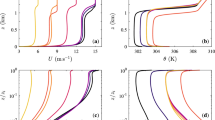Abstract
The inner part of a neutral atmospheric boundary layer has been simulated in a wind tunnel, using air injection through the wind tunnel floor to thicken the boundary layer. The flow over both a rural area and an urban area has been simulated by adapting the roughness of the wind tunnel floor. Due to the thickening of the boundary layer the scaling factor of atmospheric boundary layer simulation with air injection is considerably smaller than that without air injection. This reduction of the scaling factor is very important for the simulation of atmospheric dispersion problems in a wind tunnel.
The time-mean velocity distribution, turbulence intensity, Reynolds stress and turbulence spectra have been measured in the inner part of the wind tunnel boundary layer. The results are in rather good agreement with atmospheric measurements.
Access this article
We’re sorry, something doesn't seem to be working properly.
Please try refreshing the page. If that doesn't work, please contact support so we can address the problem.
Similar content being viewed by others
Abbreviations
- d :
-
Zero plane displacement, m
- h :
-
Height of roughness elements, m
- k :
-
Von Kármán's constant
- n :
-
Frequency of turbulence velocity component, s−1
- S u(n):
-
Energy spectrum for longitudinal turbulence velocity component, m2 s−1
- S v(n):
-
Energy spectrum for lateral turbulence velocity component, m2 s−1
- S w(n):
-
Energy spectrum for vertical turbulence velocity component, m2 s−1
- U o :
-
Free stream velocity outside the boundary layer, m s−1
- ŭ :
-
Time-mean velocity inside the boundary layer, m s−1
- u*:
-
Wall-friction velocity, m s−1
- u′ :
-
Longitudinal turbulence intensity, m s−1
- v′ :
-
Lateral turbulence intensity, m s−1
- w′ :
-
Vertical turbulence intensity, m s−1
- \(- \overline {uw} \) :
-
Reynolds stress, m2 s−2
- z :
-
Height above earth's surface or wind tunnel floor, m
- z o :
-
Roughness length, m
- δ :
-
Thickness of inner part of boundary layer, m
- δ′ :
-
Thickness of boundary layer, m
- ν :
-
Kinematic viscosity, m2 s−1
References
Cermak JE (1971) AIAAJ 6: 1746.
Davenport AG and Isyumov N (1968) The application of the boundary layer wind tunnel to the prediction of wind loading. Proc Int Research Seminar on Wind Effects on Buildings and Structures, Toronto.
Counihan J (1969) Atmos Envir 3: 197.
Cook NJ (1973) Atmos Envir 7: 691.
Schon JP and Mery P (1971) Atmos Envir 5: 299.
Counihan J (1975) Atmos Envir 9: 871.
ESDU (1972) Characteristics of the wind speed in the lower layers of the atmosphere near the ground: strong winds (neutral atmosphere). ESD Item No. 72026, Engineering Sciences Data Unit Ltd, London.
Hinze JO (1975) Turbulence. New York: McGraw-Hill.
Kaimal JC, Wyngaard, JC, Izumi Y and Coté OR (1972) JR Met Soc 98: 563.
Synder WH (1972) Boundary-Layer Meteorol 3: 113.
Author information
Authors and Affiliations
Rights and permissions
About this article
Cite this article
Sluman, T.J., van Maanen, H.R.E. & Ooms, G. Atmospheric boundary layer simulation in a wind tunnel, using air injection. Appl. Sci. Res. 36, 289–307 (1980). https://doi.org/10.1007/BF00385769
Received:
Revised:
Issue Date:
DOI: https://doi.org/10.1007/BF00385769




